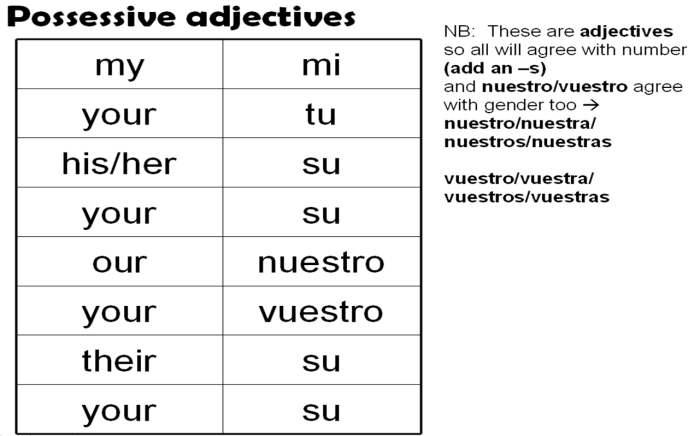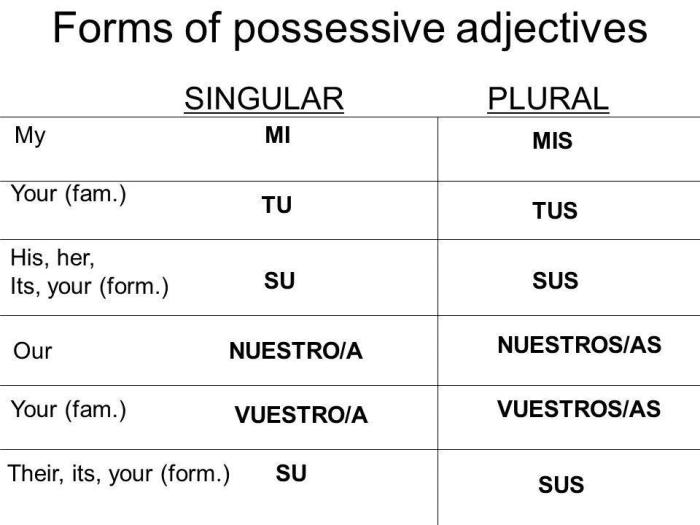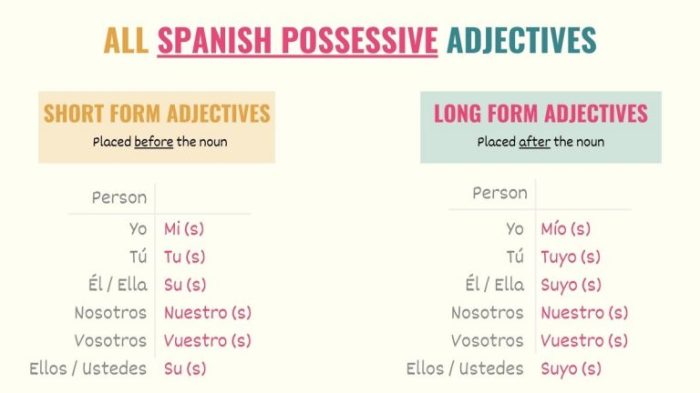Possessive adjectives in spanish worksheet – Embark on an in-depth exploration of possessive adjectives in Spanish with this comprehensive worksheet. Designed to enhance your understanding of this fundamental grammatical concept, this guide will delve into the intricacies of possessive adjectives, empowering you to express ownership and possession with precision in Spanish.
Delve into the diverse types of possessive adjectives, their correct usage, and their placement within sentences. Engage in interactive exercises and activities tailored to reinforce your learning, ensuring a deep comprehension of possessive adjectives.
Possessive Adjectives in Spanish: Overview: Possessive Adjectives In Spanish Worksheet

Possessive adjectives in Spanish grammar indicate ownership or possession of a noun. They agree in number and gender with the noun they modify and are placed before the noun.
There are two types of possessive adjectives in Spanish: possessive adjectives for nouns and possessive adjectives for pronouns.
Possessive Adjectives for Nouns
Possessive adjectives for nouns are used to indicate ownership of a noun. They agree in number and gender with the noun they modify and are placed before the noun.
- mi (my)
- tu (your)
- su (his, her, your formal)
- nuestro (our)
- vuestro (your plural)
- su (their)
Possessive Adjectives for Pronouns, Possessive adjectives in spanish worksheet
Possessive adjectives for pronouns are used to indicate ownership of a pronoun. They agree in number and gender with the pronoun they modify and are placed after the pronoun.
- mío (mine)
- tuyo (yours)
- suyo (his, hers, yours formal)
- nuestro (ours)
- vuestro (yours plural)
- suyo (theirs)
Examples
- Mi casa es grande. (My house is big.)
- Tu coche es nuevo. (Your car is new.)
- Su perro es muy inteligente. (His dog is very intelligent.)
- Nuestra casa es pequeña. (Our house is small.)
- Vuestra comida es deliciosa. (Your food is delicious.)
- Su casa es muy bonita. (Their house is very beautiful.)
FAQ Insights
What are the different types of possessive adjectives in Spanish?
Spanish possessive adjectives vary according to the person (first, second, third) and number (singular, plural) of the possessor.
How do I correctly place possessive adjectives in Spanish sentences?
Generally, possessive adjectives precede the noun they modify. However, exceptions exist, such as when the noun is modified by a demonstrative adjective or when the possessive adjective is used as a pronoun.
Can possessive adjectives be used as pronouns in Spanish?
Yes, possessive adjectives can function as pronouns when they stand alone to refer to a previously mentioned noun. In such cases, they take the definite article.

